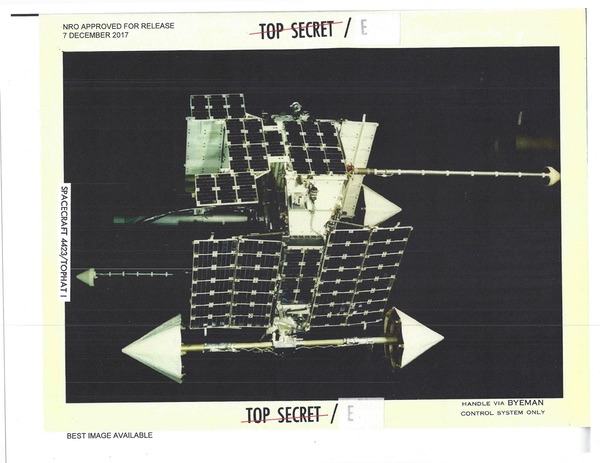Applied witchcraft: American communications intelligence satellites during the 1960sby Dwayne A. Day
|
| Even if low orbits did not provide the dwell time over the target necessary to gather up lengthy intercepts, they could, and did, provide indications of the type and amount and transmitter locations of Soviet communications, the kind of information that signals experts call “traffic analysis.” |
What the Midway example demonstrated was that even when communications interceptions were limited, they could provide valuable clues. This was one of the motivating factors in the United States’ development of low Earth orbit communications intelligence (COMINT) satellites in the early 1960s. Satellites flying only a few hundred kilometers above Earth’s surface spend a short time within range of an emitter, so trying to gather up communications signals was akin to trying to listen in on a conversation between two people as you ride past on a bicycle.
The National Reconnaissance Office (NRO), which operated America’s intelligence satellites starting in the early 1960s, flew many communications intelligence payloads in low Earth orbit. Some of these sought out voice communications, but others gathered up teletype and perhaps other forms of communications within the vast expanse of the Soviet Union. Even if low orbits did not provide the dwell time over the target necessary to gather up lengthy intercepts, they could, and did, provide indications of the type and amount and transmitter locations of Soviet communications, the kind of information that signals experts call “traffic analysis.” These platforms helped pave the way for the high-altitude COMINT platforms that followed late in the decade, and they most likely helped make the case that COMINT from space would be highly productive if only the satellites could fly higher to gather more signals.
The INTs and the AFTRACKs
Signals intelligence, or SIGINT, is the overall term encompassing several subfields including electronic intelligence (ELINT)—primarily the interception of radar signals—and communications intelligence (COMINT). The United States began flying signals intelligence payloads on satellites by the early 1960s. Although writers in the popular press often referred to America’s smaller intelligence satellites as “ferrets” or “elints,” the former term was not used within the satellite intelligence community and the latter was apparently very uncommon.
Radar signals were of high importance during the early days of satellite intelligence, but the intelligence community knew that their primary target, the Soviet Union, broadcast many of their important military communications via radio waves rather than secure landlines. In August 1959, Roger Thayer of the National Security Agency wrote the “Study Report on Collection of COMINT from Satellite Vehicles” where he suggested that the Samos Subsystem F satellite payloads—which were intended to intercept Soviet radar signals—could be adapted to COMINT.
Many of the signals intelligence payloads launched in the early 1960s were small electronic boxes affixed to the aft rack just forward of the engine on Agena spacecraft. The Agena served as both a second stage during launch and supported reconnaissance cameras at their front—earning these electronic interceptors mounted near the back the designation of AFTRACK payloads. One declassified document that regularly referred to early AFTRACK payloads as “elints” had the word crossed out in pencil wherever it appeared. AFTRACK payloads eventually evolved to include much more than simply ELINT missions, evolving into an array of electronics boxes used to chase almost every kind of signal that emanated from the Soviet Union.
Finding the signals and deciphering them was an esoteric art. Lockheed, which manufactured the Agena and was also responsible for incorporating AFTRACK payloads into them, soon had a cover image of a witch on a rocket-powered broomstick orbiting the Earth and carrying a banner that said “Applied Witchcraft.”
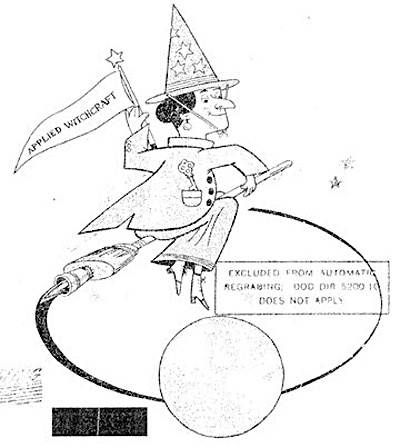 Cartoon from a declassified Lockheed document about a 1960s-era communications intelligence payload. (credit: NRO) |
COMINT goes to orbit
Captain Don Wipperman at the Air Force Security Service in San Antonio came up with the first COMINT satellite concept. Working with the Airborne Instrument Laboratory team, he presented a proposal for an AFTRACK payload that could intercept a signal that was then thought to be the air-to-ground and ground-to-air communications network in the USSR, the primary way that Soviet military pilots talked to personnel on the ground. The new payload became known as TEXAS PINT and launched on August 30, 1961, on the Agena aft rack of a CORONA spacecraft. But when analysts processed the signals, they determined that the Soviets had apparently started phasing out that system in favor of a more advanced communications network. TEXAS PINT still managed to collect very high frequency (VHF) data over the Soviet Union that was later used to design other signals intelligence payloads.
| Finding the signals and deciphering them was an esoteric art. Lockheed had a cover image of a witch on a rocket-powered broomstick orbiting the Earth and carrying a banner that said “Applied Witchcraft.” |
In the summer of 1961, Sanders Associated developed two NEW JERSEY payloads to intercept the new air-to-ground signals. They were named NEW JERSEY because the original idea had come from ITT in Nutley, New Jersey. The first was launched on July 27, 1962, and the second on January 7, 1963. They intercepted and located several signals using Doppler techniques. Sanders began working on a follow-on payload named NEW HAMPSHIRE, but it ran into difficulties and never flew.
Wayne Burnett of HRB-Singer at State College, Pennsylvania, proposed a concept for intercepting, encoding, and recording a radio teletype channel of the Soviet point-to-point VHF multichannel communications signal. The downlink signal from the satellite had to be encrypted to prevent the Soviets from detecting the interception. The National Security Agency supplied an encryption device that was used during readout. HRB engineer Conrad Welch invented the intercept electronics, and the payloads were named GRAPE JUICE. They were launched on December 12, 1961; April 17, 1962; and September 17, 1962. Unfortunately, European TV and FM radio stations created so much interference that the GRAPE JUICE payloads were only able to lock onto the desired signal for short periods.
Following the frustrations with GRAPE JUICE, the engineers developed more filtering and better logic systems and produced the more refined VINO payload (sometimes referred to as “RED VINO”) launched on December 4, 1962. By March 1963, the Committee on Overhead Reconnaissance (COMOR) Target Working Group, which established priorities for satellite intelligence collection, indicated that the highest priority COMINT signal was a major command link among Strategic Rocket Forces. But the working group determined that it would be difficult intercepting these signals. The second highest COMINT priority was going after the RED VINO teletype signals.
A final version named OPPORKNOCKITY was launched on August 21, 1964. The name was an old, inside joke among people in the radio frequency business, a play on the saying that opportunity only knocks once—OPPORKNOCKITY, in contrast, only tuned once. It was designed to hold lock on the signal through extensive interference.
OPPORKNOCKITY proved to be a mixed success. It made 12,000 intercepts and brought back larger amounts of data than its predecessors, but the designers still did not consider it to be an ideal system for the type of intelligence they required. After the first one flew, officials evaluated whether to fly a second one. An extra OPPORKNOCKITY payload, developed as the service test model for the flown item, was in storage. But officials determined that it was obsolete and it apparently never flew.
Bigger payloads and bigger dishes
SQUARE TWENTY was designed to locate Soviet communications links of a type that is still classified, but may have been the Strategic Rocket Forces communications link that COMOR had identified as the highest priority COMINT target. Although no photographs or illustrations of the SQUARE TWENTY payload have been released, it was a substantial system mounted to the back end of CORONA satellites, including two large deployed antennas. SQUARE TWENTY had a pencil beam antenna consisting of a downward-pointing approximately two-meter diameter parabolic dish. It was also equipped with a fan beam antenna that was a two-meter-long curved rectangular section with a parabolic taper that looked forward in the direction of vehicle motion. As the vehicle orbited the Earth, the fan beam antenna would be the first to pick up signals, with the pencil beam antenna capturing more accurate information as the satellite flew overhead, assuming that the emitter was within the antenna’s field of view.
| The name was an old, inside joke among people in the radio frequency business, a play on the saying that opportunity only knocks once—OPPORKNOCKITY, in contrast, only tuned once. |
The SQUARE TWENTY payload was launched on October 28, 1965, and lasted for 11 days, producing many locations of signal emitters. SQUARE TWENTY made 1,290 intercepts, resulting in 209 communications transmitter locations, producing still-classified accuracy results that were determined after multiple intercepts, and an accuracy of approximately 18-92 kilometers based upon single intercepts. Although SQUARE TWENTY had the ability to copy the collected data, it was not able to lock on for long enough periods and the data was not useful—apparently the analysts were able to determine where the transmissions were occurring, but not what was actually being communicated. By early 1967, another SQUARE TWENTY payload, this time with an dish more than three meters in diameter, was scheduled for flight in the fall. But it is unclear if this mission flew and what spacecraft carried it.
By 1965, when SQUARE TWENTY went into orbit, the AFTRACK payloads were no longer as useful as they had once been. The reasons remain classified, but some of the limitations of this approach to gathering signals intelligence are obvious, including the fact that the payloads had to fly attached to a battery-powered spacecraft that was intended to perform a photo-reconnaissance mission and was not optimized for signals intelligence. In addition, power and lifetime were determined by the primary payload—if signals intelligence analysts wanted more power or to stay in orbit longer collecting more signals, they were out of luck, since the satellites reentered and burned up in the atmosphere after they had returned their last film capsule. By 1965, more than 40 AFTRACK payloads had flown in orbit, not counting the prodigious STOPPER and BIT payloads used to determine if the Soviet Union was trying to track and even hack into the communications systems of American reconnaissance satellites.
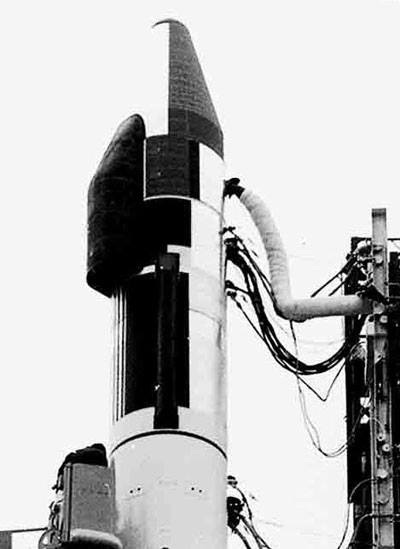 The unusual adaptation to allow the DONKEY communications intelligence antenna to be carried on the MULTIGROUP satellite. (credit: Peter Hunter Collection) |
DONKEY
One unique COMINT payload had an unusual origin story. When the Manned Orbiting Laboratory (MOL) program was started in late 1963, it was going to be an incredibly complex machine, both a human space station and a collection of military experiments and equipment for performing an operational intelligence collection mission. One of MOL’s early payloads was a communications intelligence collection system codenamed DONKEY.
The DONKEY payload’s mission was to intercept signals from a Soviet microwave communications system used by both civilian and military operators. The precise target system remains classified, but it apparently consisted of a network of transmitters throughout the Soviet Union. Intercepting the transmitters’ main beams would be difficult, but collecting from their sidelobes, which radiated out from a transmitter’s sides like the feathers on a peacock, would increase intercept times while a satellite was overhead. It could possibly gather up enough information to determine what was being transmitted over the network.
For MOL, DONKEY would use a six-foot (two-meter) diameter parabolic “wrapped rib” antenna that would unfold from the side of the big cylindrical spacecraft. Unlike an umbrella-type dish, the antenna wrapped flexible ribs and the mesh antenna strung between them around a central spoke, enabling a larger diameter antenna to be packed in a smaller volume.
E-Systems in Garland, Texas, and EDL-Sylvania developed a test system installed in the E-Systems facility. An Air Force helicopter flew a payload in an intercept pattern through the main beam and sidelobes of a microwave antenna at the E-Systems facility outside Dallas. EDL analysts examined the collected data and made recommendations for a mission. They determined that a three-axis stabilized satellite was needed for the payload. The payload activities were handled within the BYEMAN security control system under a unique management arrangement.
Sometime in 1965, DONKEY was eliminated from MOL. But by November 1965, COMOR now had a SIGINT Working Group, which established requirements for US signals intelligence satellites. The working group determined that the information transferred over the Soviet communications network had “high intelligence value.” The group declared that a system was required “to obtain sufficient technical data concerning the location, antenna patterns, and modulation of the [deleted] system to permit valid consideration of [a] follow-on collection system.” The group also indicated that this data could be useful for a planned geosynchronous signals intelligence collection system whose name was deleted from the document, but was almost certainly the CANYON satellite then being built by Lockheed and eventually launched in 1968.
With DONKEY no longer part of the MOL program, National Reconnaissance Office officials soon transferred the project to the program office in Los Angeles that operated the NRO’s growing stable of SIGINT satellites. It is unclear when or why the payload was named DONKEY, although it clearly had this codename by early 1966. Program managers and engineers began evaluating how to fly DONKEY. Apparently, they initially considered putting the payload on a small dorm-refrigerator-sized P-11 satellite of the type routinely pushed off the back of Agena spacecraft with CORONA or GAMBIT photo-reconnaissance payloads. But for unknown reasons the P-11 proved unsuitable.
Soon engineers looked at mounting DONKEY to the rear of an Agena-based signals intelligence spacecraft named MULTIGROUP, so-named because it carried up to eight different signals intelligence payloads in its nose. DONKEY would have been the last AFTRACK payload. But whereas CORONA and GAMBIT reconnaissance satellites flew parallel to the Earth’s surface, affording an AFTRACK payload an unobstructed view down toward the Earth, the MULTIGROUP satellite would point nose-down at the Earth with its nest of antennas at the front and three solar panels sticking out at the back. Engineers evaluating mounting DONKEY at the aft end of a MULTIGROUP satellite determined that the back of the Agena would be a poor location for DONKEY’s large antenna, because it would interfere with the solar panels located there. Engineers soon determined that the best location was the front of the MULTIGROUP satellite. But the front of the Agena also presented problems as well because MULTIGROUP was already crammed with payloads. The satellite had three other outboard antennas, so packing a fourth, large antenna into that space required careful planning. Engineers came up with an unusual solution: a bulge in the side of the spacecraft’s payload fairing to fit the extra antenna for DONKEY.
On July 24, 1967, the second MULTIGROUP satellite was launched carrying the DONKEY payload. After the Agena placed it in orbit and the payload fairing was jettisoned, the Agena pitched nose down and MULTIGROUP began deploying its antennas. The mission consisted of several MULTIGROUP payloads looking at a range of frequency bands, DONKEY, and another payload codenamed SETTER, named after a pointing dog because of its ability to accurately locate the emitters that it detected.
| DONKEY, the payload that was kicked off of MOL because it was not part of the spacecraft’s primary mission, was the only part of MOL that actually gathered intelligence. |
DONKEY ran into problems almost immediately when its antenna pointing mechanism failed. This prevented it from performing the sidelobe collection mission. It could not gather signals for long enough to provide useful intelligence about them. It is unclear if SETTER provided location data for the things that DONKEY detected, but DONKEY was still able to map emitter locations in the Soviet Union, leading to development of a grid that indicated a large majority of the emitters throughout the Soviet landmass. That data proved valuable for later collection activities that remain classified.
DONKEY also made it possible to map communications facilities located at Sary Shagan, the sprawling Soviet radar and anti-ballistic missile (ABM) testing facility on the edge of Lake Balkhash in Kazakhstan. Sary Shagan’s radars tracked ballistic missiles as well as satellites, and was already a high-priority target for the ELINT payloads that the National Reconnaissance Office was flying. But the engineers at Sary Shagan also had to communicate with other facilities and Moscow, and DONKEY helped figure out how the facility was connected. Whether DONKEY was intercepting voice communications or data transmissions about the radar operations is unclear.
The MULTIGROUP satellite’s data link transmitter eventually failed, ending its transmissions of intelligence data. But DONKEY had an independent downlink and operated for 182 days, 30 days longer than the other satellite payloads. MOL was canceled two years after DONKEY flew, and none of its hardware made it into space, meaning that the payload that was kicked off of MOL because it was not part of the spacecraft’s primary mission was the only part of MOL that actually gathered intelligence.
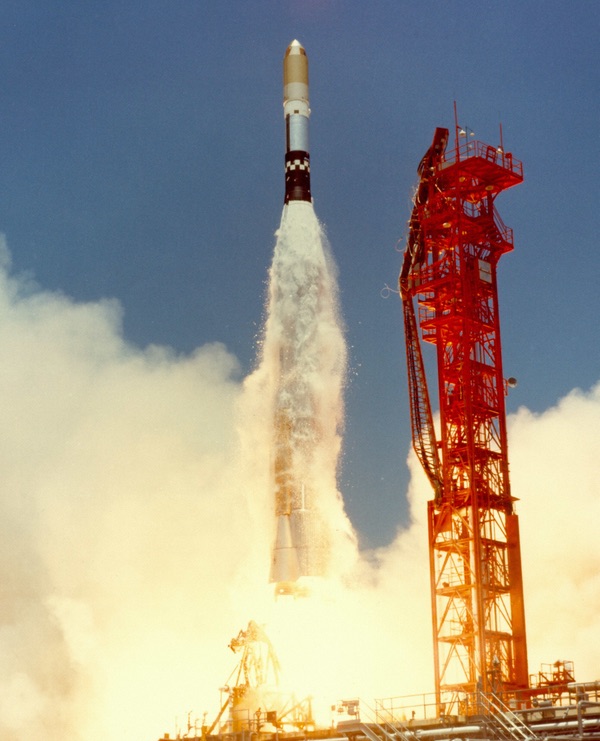 The May 1977 launch of a CANYON communications intelligence satellite that operated in high orbit. (credit: Peter Hunter Collection) |
Programs 11 and 989
One of the inherent problems of the AFTRACK signals intelligence payloads is that they were secondary to the main mission: the CORONA and GAMBIT satellites’ mission was photography, which determined the orbits and the mission durations. But those reconnaissance satellites were also battery powered, meaning that even if their operators wanted to continue the AFTRACK missions after all the film was returned, there was not much power left to do so. The solution was to develop small, dedicated satellites that could carry SIGINT payloads. The first satellites were developed as part of Program 11, or P-11 for short, and launched starting in 1963. At some point the program was apparently redesignated as P-989, although even after this happened the P-11 designation was used as a shorthand reference to these small satellites.
Throughout the 1960s, numerous P-11 and, later, P-989 satellites were launched off the backs of reconnaissance satellites. Most were devoted to radar signal detection. But according to a declassified history, several also had COMINT missions. These satellites had names such as WESTON (launched in 1969), TOPHAT (launched in 1970 and 1974), and ARROYO (launched in 1971). Nothing is known about their targets.
All of these low-altitude COMINT collectors could not intercept signals for more than a few minutes over their targets. But this enabled some basic mapping of Soviet communications networks, and some traffic analysis. As SIGINT analysts had learned decades earlier, even if they could not break an adversary’s encryption, they could identify patterns based upon who was transmitting to whom and how often. This could help in the development of new COMINT systems.
As historian James David noted in a 2018 article about COMINT satellites in Quest: The History of Spaceflight, by the mid-1960s the US intelligence community had mapped out a vast network of Soviet microwave transmission towers. It was near impossible for the CIA to tap a telephone cable inside of the Soviet Union, but these microwave transmitters were sending their signals from towers placed far distances from each other, and the signals continued right past the towers and out into space. A satellite that slowly moved through the microwave beam could collect them.
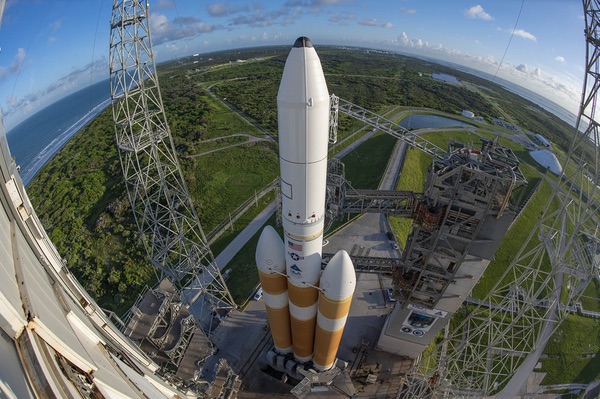 The Delta IV Heavy rocket currently awaiting launch at Cape Canaveral. It carries a signals intelligence satellite, the latest in a 60-year legacy of gathering signals intelligence from orbit. (credit: ULA) |
CANYON
In August 1968, the first of a new class of COMINT satellites was launched into orbit from Cape Canaveral. The satellite went into near-geosynchronous orbit of 32,600 by 39,200 kilometers, far higher than the low Earth orbit satellites that had previously carried COMINT payloads. With a 10.2-degree inclination to the equator, the satellite drifted in a figure-eight pattern 10.2 degrees above and below the Equator.
| One Lockheed engineer who had been sent to Germany to set up the ground station and receive the signals from the satellite found himself with nothing to do for the next six months but travel around the country playing tourist, waiting for the next launch. |
The satellite was built by Lockheed, and had a mesh antenna 9.1 meters in diameter. Although the name was classified, the satellite was known as CANYON, and its mission was to intercept the signals from Soviet microwave transmissions as they leaked out into space, almost certainly based upon an understanding of those transmissions gleaned from earlier low-altitude COMINT intercepts. But soon after the satellite entered orbit, a ground controller made a critical error that sent the bird into an uncontrollable spin, turning it into a highly classified, expensive piece of space junk.
Bad Aibling, Germany hosted the ground station for the satellite, where the CANYON effort had the unclassified designation Project WILD BORE. One Lockheed engineer who had been sent to Germany to set up the ground station and receive the signals from the satellite found himself with nothing to do for the next six months but travel around the country playing tourist, waiting for the next launch.
In April 1969, the Air Force launched the second CANYON satellite, followed by a third in September 1970. The satellites continued to experience problems, with communications between the satellite and ground station occasionally failing.
From CANYON’s much higher perch. Soviet communications traffic started arriving in large quantities at the ground station. Tapes were made and taken to Munich to fly back to NSA Headquarters in Maryland.
Because the Soviets did not think the communications could be intercepted, they did not encrypt most of them. This situation presented a dilemma: there were so many intercepted Russian-language communications that it swamped the NSA’s translation capabilities. To solve the problem, the US turned to two of its partners in the UKUSA, a coalition consisting of the United States, United Kingdom, Canada, Australia, and New Zealand, that agreed to share some signals intelligence data among them. The US turned to Canada and the United Kingdom for help processing the CANYON data. In exchange for the manpower provided, the allies received access to the CANYON communications intelligence. What none of the partners realized at the time was that one of the British citizens who gained access to the CANYON data was a Soviet spy.
In the early 1960s, collecting COMINT from space was like trying to listen to a few whispers in a hurricane. Once CANYON debuted, those whispers turned into a roar. Today, the UKUSA intelligence coalition is known as the FIVE EYES signals intelligence alliance. Currently sitting on a launch pad in Cape Canaveral is a powerful Delta IV Heavy rocket. Inside its nosecone is a National Reconnaissance Office signals intelligence satellite that will be launched into a geosynchronous orbit. For the first time, the NRO stated that the satellite represented “the solidarity across the Five Eyes community.” That rocket has had numerous problems getting off the pad. But when the top-secret satellite eventually reaches orbit, it will become the latest chapter in a legacy of over half a century of applied witchcraft, gathering COMINT from space.
Note: we are temporarily moderating all comments submitted to deal with a surge in spam.
